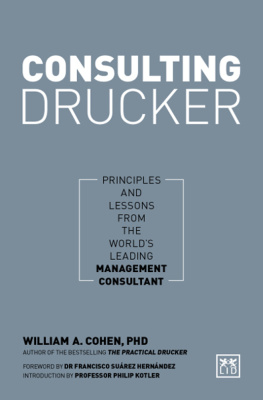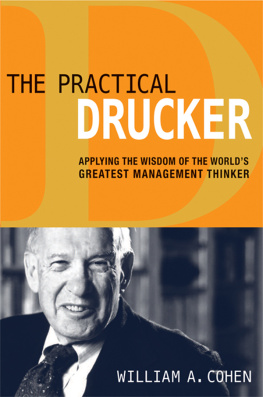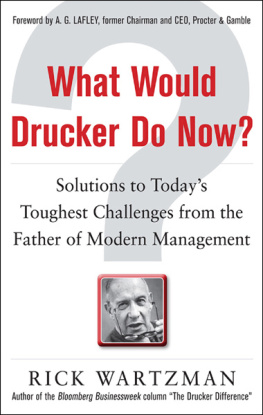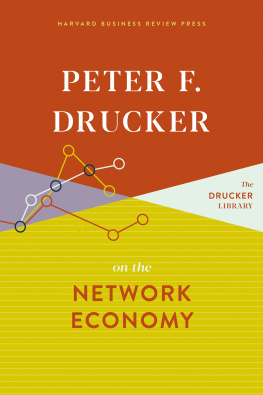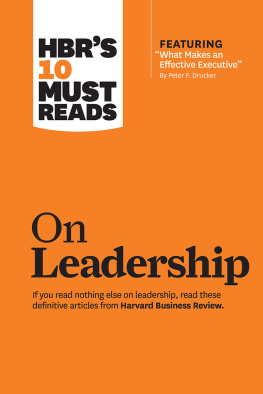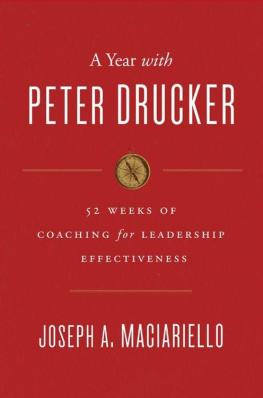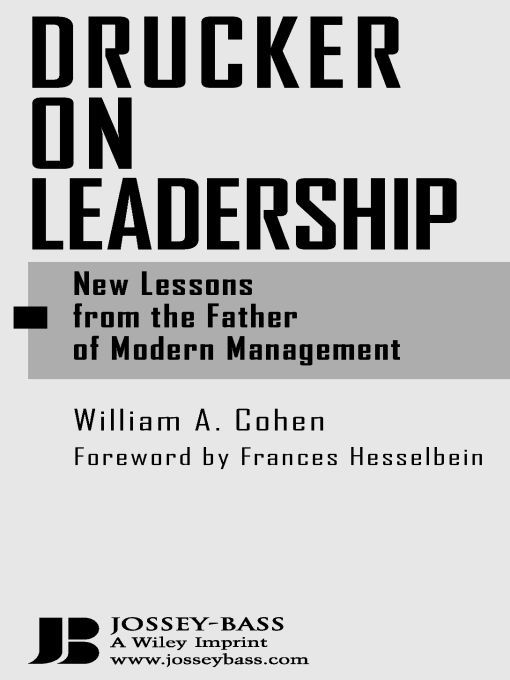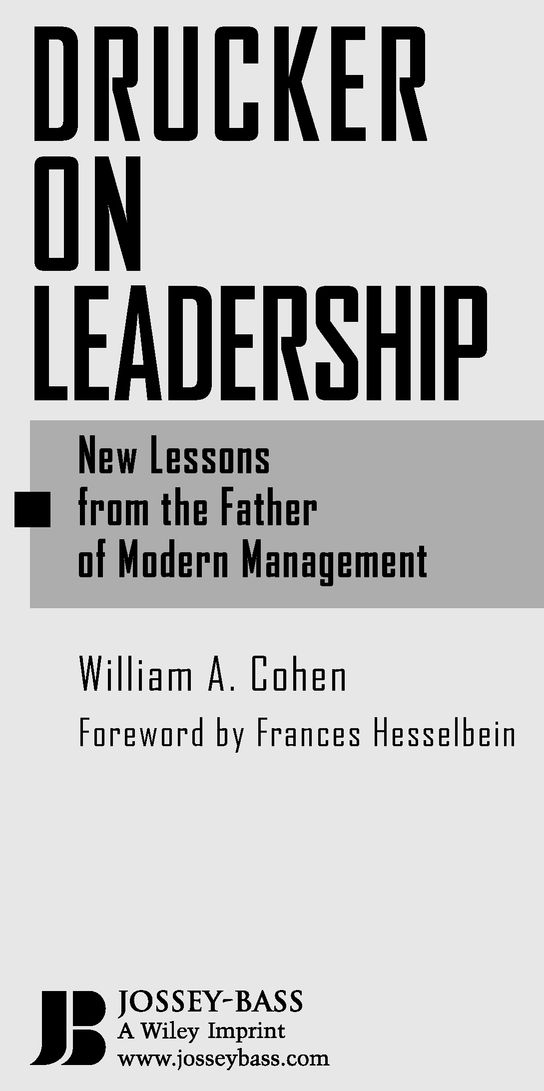Table of Contents
Praise forDrucker on Leadership
What Cohen learned as Peter Druckers student, and their personal relationship afterwards, changed Bills life. Reading Drucker on Leadership will change the way you look at and apply leadership forever.
Bruce Rosenstein, author of Living in More Than One World: How Peter Druckers Wisdom Can Inspire and Transform Your Life
Peter F. Drucker helped me found the Peter F. Drucker Academy in China. It is a pleasure to see his concepts and what he instructed me brought together in one place and explained so that they could be applied by any executive. Drucker on Leadership is a valuable and useful book.
Minglo Shao, chairman and CEO of the Bright China Group and founder of the Peter F. Drucker Academy
For Doris Drucker
The First Lady of the Peter F. Drucker and
Masatoshi Ito Graduate School of Management
but more than thatthe author of a best-selling book,
the founder and CEO of a medical device company,
and a woman who not only stood by her man
for almost seventy years
but continues to travel the world
promoting his principles.
FOREWORD
by Frances Hesselbein
For those who sit at the feet of Peter Drucker, and always will, and for those just discovering our greatest leadership philosopher, Drucker on Leadership is a rare and timely gift, as we approach the great celebration of Peter Druckers hundredth birthday. And who better to bring us this exciting new book, these new observations, than Druckers first Executive Ph.D. graduate. No one else can claim this unique statusa thirty-year relationship with Peter, a unique understanding of almost a third of Peter Druckers journey that he shared.
The Peter F. Drucker Foundation for Nonprofit Management was established in 1990. Six weeks after I had left the CEO position at the Girl Scouts of the USA, I found myself the CEO of the new Drucker Foundation. We had ten inspiring years with Peter Drucker as our honorary chairman. He attended our board meetings, three times a year for ten years, spoke at every conference we held, and wrote forewords and chapters for many of our twenty six books. All of usboard members, staff members, and allhad numerous opportunities to listen to, dialogue with, work on the written and spoken word with Peter Drucker. With gratitude we absorbed and appreciated his messages, his voice, his timeless philosophy.
When Peter became frail, unable to be with us in person, we decided that the most loving and respectful thing we could do was to return his name to the family; we became the Leader to Leader Institute, taking the name of our journal, Leader to Leader. But it is the same organization, still committed to moving Peter Druckers works, his philosophy, his message across all three sectors and around the world. We are as committed today as we were in March 1990 when the Drucker Foundation was born.
I share this preamble to the Introduction with you because my reflections on Bill Cohens Drucker on Leadership have a deep and close appreciation and experience with the hero of the book, and I can say with documented certainty that Cohens Drucker on Leadership is pure Drucker. Every chapter brings a fresh, new approach to understanding the world, the works, the leadership philosophy of Peter Drucker. I read the manuscript with a critical eye, for I felt I owed Bill Cohen an alert if a Drucker concept did not come through clearly or was not consistent with the Peter Drucker that the Girl Scouts of the USA and the Drucker Foundation (Leader to Leader Institute) welcomed, understood, practiced, made their own.
Drucker on Leadership passes this most rigorous testthese lessons are the lessons all those who sat at the feet of Peter Drucker learned, practiced, and lived: the Drucker philosophy. To this day I quote Peter to audiences in all three sectors: for example, The U.S. Army does the best job of developing leaders, because it develops leaders from within. Bill Cohens analysis in Part Three captures Peters respect for the military model of leadership development.
Strategic planning is strengthened by The best way to predict the future is to create it. We see T shirts with this wisdom. Peter was the model for the principled, ethical leader. Almost one hundred years of his gift of example in leadership and ethics sustains us in our times when far too many have lost their way.
And when it comes to marketing, with A business has just two functionsmarketing and innovation, Peter lights a fire.
In Part One, Bill Cohen is faithful to Peters focus on mission, defined as why we do what we do, our reason for being, which is all about the desired future. Determining what business we are in is a primary responsibility of the leader and the power of inclusion comes through clearly, along with determining who is our customer, an equally powerful message.
Creating an organizations future may seem a formidable task in our uncertain times, when few dare to describe the futureeven ten years from nowyet in this book are guidelines for that journey into an uncertain future. Druckers concepts of the process of creating an organizations future give reassurance to todays planners of the future. When I finished Bill Cohens book, I felt as though I had been listening to the voice of Peter Drucker himself.
Bill Cohen has been a faithful student, a faithful friend, a faithful disciple, and now with Drucker on Leadership he has, and I use a term I learned from Peter, truly kept the faith.
INTRODUCTION
Peter Drucker and Leadership
There is little doubt that Peter Drucker, the Father of Modern Management, considered leadership the essential management skill. As early as 1947, he declared in Harpers Magazine, Management is leadership. However, despite these clear early statements, Drucker did at times seem to equivocate about leadership. Only a few short sentences after the statement about the importance of leadership, for example, he added, Leadership cannot be taught or learned.
Clearly, Drucker was ambivalent about leadershipor at least the idea that it could be taughtand he remained so for much of his career. In Management: Tasks, Responsibilities, Practices, published in 1973, he reiterated, There is no substitute for leadership. But management cannot create leaders, and, although the book ran 839 pages, leadership did not appear as a topic in its own right.
Druckers Evolving Attitudes Toward Leadership
Despite his clear belief in its importance, leadership never became the focus of Druckers writing. Why this strange conflict?
While we cant know for certain why Drucker was reluctant to tackle leadership head on, we do know that as a young man, Drucker witnessed the rise of Hitler, whose titleFuehrermeans Leader. That association may well have had lifelong resonance. Drucker himself, sure of what was coming, left Germany almost immediately after Hitlers rise to power. Still, Hitlers success baffled him. Why did so many flock to his leadership? In the end, he concluded, Hitler was a misleader. Misleaders, he said, were charismaticanother characteristic of leadership that Drucker had difficulty accepting.
Despite his struggle with the concept, he was well aware that leadership had a critical impact on any project and human endeavor. At the same time, he intuitively recognized that leadership


